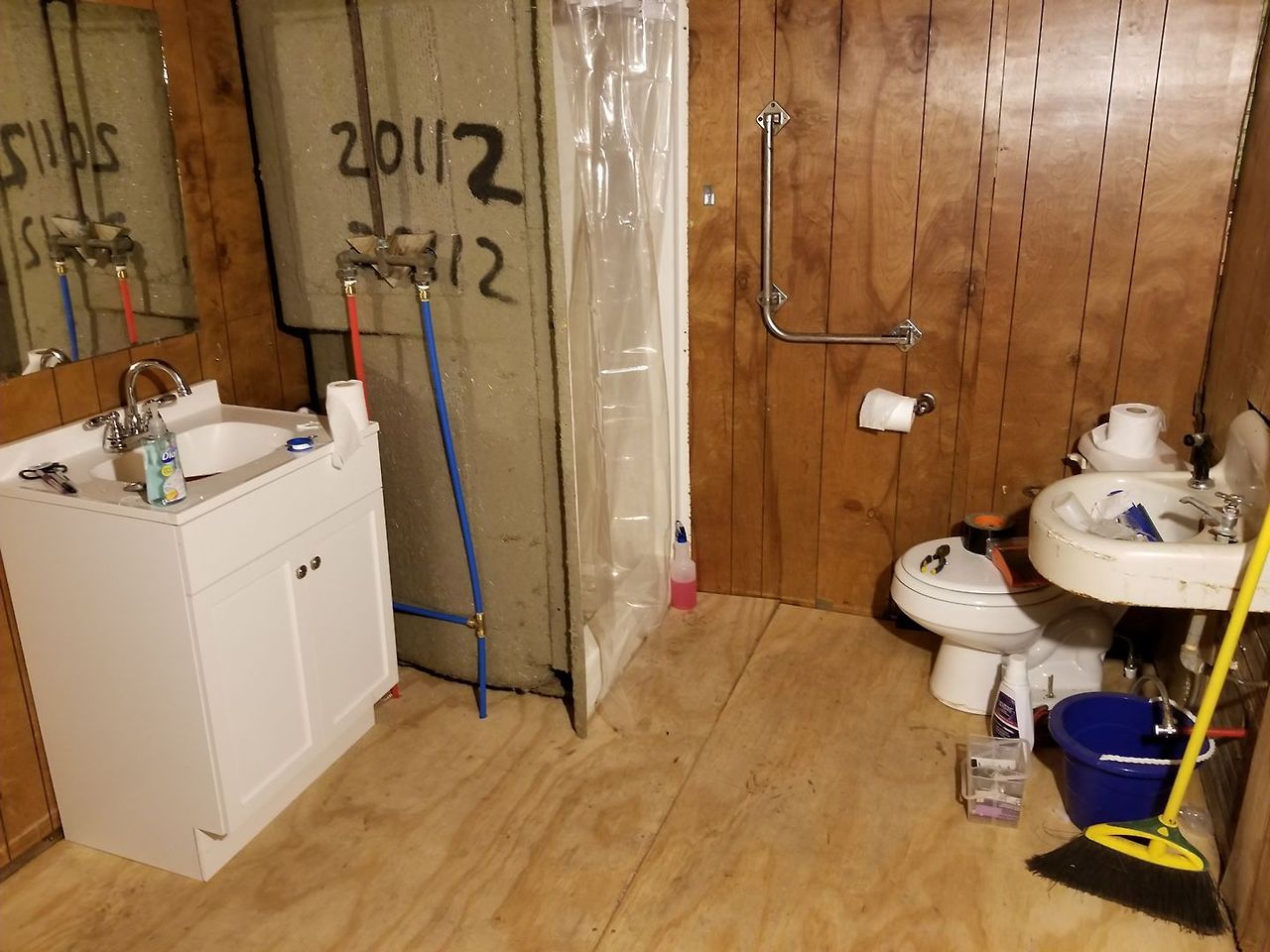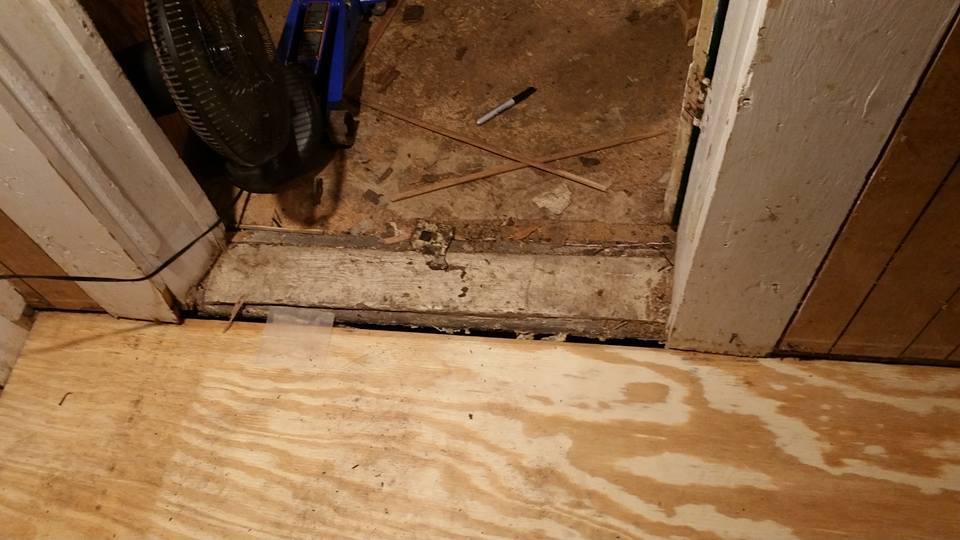Nick
In Remembrance
My Nepthue did a OD on us 3 weeks ago after being clean for a year , Leaving a 4 year old daughter .

I placed my MTI acrylic shower base into a bed of concrete -it made the base feel very secure and very solid (i.e. once the concrete had become hard).
Now, I followed the acrylic base manufacturer's suggestion of covering the wet bed of concrete with a sheet of 6-mil polyethylene (vapor barrier) sheet just before placing the shower base on top. This was an excellent suggestion. When I first stood on the base to "tamp" it down into the wet concrete bed, it occurred that there was a little too much concrete to allow the base to fully settle to the correct position. It was very easy to then temporarily remove the base - as there was no sticking to the concrete and there was no mess. I quickly pulled up the polythene sheet and redistributed the wet concrete as appropriate. I again covered the base with the sheet of polyethelene and tried again to embed the base into the concrete as before - it worked extremely well.
Now, after concrete curing, the polyethylene sheet will also act somewhat as a stress/stgrain "decoupler" between the concrete and the acrylic base - a good idea in itself.
I'm sorry to hear that. :-(
The 26th thing is an odd coincidence.
My friend's bathroom is coming along more.

He temporarily hooked up the shower to test it out. Still needs to put moisture barrier and stuff around and under where it is. Still need to paint the walls and get some more permanent flooring in once gaps and holes are sealed up.
Trying to figure out how to fill up this gap (there's nothing below this spot and it's actually larger than it looks) and what flooring to get. He can't afford anything pricey. I'm wondering if he could just paint it, because the sheet vinyl all seems to be too expensive. Couldn't find any remnants large enough. The room is almost 12'x9'.

But for now he can use the toilet and the shower. The old sink still works and he is trying to figure out how to detach it and cap off the old water supply lines that are leaking. He really likes the new vanity I found online. It's a lot sturdier than I expected for an MDF piece. Not bad for $49.
I've read that people are supposed to set showers in "mud" but I'm trying to remember if that is grout or mortar or something else. Anyone know?


Thanks! I remember John Bridge from the terrylove forums before he sort of got run off by an extremely rude poster there. John was always very nice and helpful. I think a lot of his installation discussions involve bases with tile walls. Since this is a one-piece fiberglass whole shower, I wonder if it needs some of the stuff. I saw that it needs a moisture barrier for about 18" diameter around the drain though (at least that's what I found on John's site when I looked last night).Zannej is that just a single layer of plywood? If so, how thick?
About the mud under the shower... this might help a little.
http://www.johnbridge.com/vbulletin/showthread.php?t=64553
One thing I noticed in the earlier photos is that it's single layer of plywood. For vinyl, it really ought to have two layers. With one layer, the seams will move or flex. I also noticed the plywood runs the wrong direction to the joists, especially considering it's a single layer. A second layer would help correct that.
Plywood grain should run perpendicular to the joists for strength.
In the second photo, how is the seam in the plywood supported between the joists? (red circle)
I'm pickier so I would want things done right in my own home.
So, for vinyl sheet you need a double layer of flooring? Or would one 5/8" thickness suffice if the seams were taken care of? (I'm wondering since I will be replacing some floors in my house). I know my bathroom has 2 layers of plywood. My mother's has only one. I think the guest bath and laundry area might have 2 layers. Not sure on the thickness.


Thanks for that info.There's no way to totally stop seam movement in the plywood with a single layer. Even 1 inch plywood won't make a difference. There will be some flexing at the joist, and joist can move........ shrink/expand/wiggle
The plywood seams of the second layer are always offset from the first layer. By doing this, the seam movement from the first layer can't transfer to the top layer. It also strengthens the floor.
It takes very little flexing of the floor to crack the filler at a joint.
For your friend, I don't know if I'd waste time with the drywall tape. A loose layed vinyl would help hide movement.
Excellent! I wish they had stuff like that at local garage sales. They mostly have baby clothes and useless junk.Couple weeks ago I scored on that $5 pressure washer. I was looking at the local Ace store for a wand for it. A guy I ran into said I ought to check out a garage sale near my house. He said mostly tools. I discovered mostly really old tools.
Anyhow, a cardboard produce box had misc stuff in it. Air tool fittings blow guns pressure gauges a small air filter/regulator engine compression gauge a reon regulator hose and gauge.......... stuff in the box was messy and had what looked to be Permatex #2 on a lot of it. ..messy and sticky. There was some thin strong 2 inch tow or hold down strap ......maybe for straps on a semi trailer.
What caught my eye was a cut off lower part of a plastic gallon cooking oil container. It had a lot of drill bits in it. I was about to ask how much the drill bits were and was told the entire box had to go. I noticed it said $5 written in Magic marker. They had five 1/2 inch Delta end mills (not carbide) for $15. 1/4" thru 1/2" They are in great shape and in a home made wood box.
Well took my box O crap home. Today I sorted through it. Drill bits are industrial stuff, all the same brand. They say HSS but look like cobalt.........8.5 lbs of em.Lots of duplicates. 1/16 to 5/8" very nice condition. A single 5/8 bit alone would cost more than $15
There are 1/2 dozen other bits that are larger. The 13/16 bit id Snap-On.
The air fittings cleaned up nice as did the gauges air filter, the USA made blow guns are non OSHA approved.... (unregulated flow) and a neat old tire gauge with a glass bezel. Bunch of neat stuff that I will definitely use. :birthday:
My aunt has the same illness you do. Not cruises, but working to afford vacations.Paid for another cruise over Xmas leaving Auckland
Looks like I still have to carry on working for awhile yet
https://www.seabourn.com/details?we...ode=7792&selectedMeta=Veranda Suite&shipId=SE
Starting from the bare joists, it would be nice to see at the very least 1/2" on 16" centers would work, but I'd go at least to 5/8". 1/2 inch is skating on thin ice. 3/4" T&G would be way better. Thicker is always better. If the joists are wider than 16 on center, you need even thicker material.Thanks for that info.
Just to clarify, would the top layer be laid out the same way as the bottom layer, or would I lay it perpendicular? And can I use a thinner layer on top than on bottom and still have it minimize the seam issue?
Paid for another cruise over Xmas leaving Auckland
Looks like I still have to carry on working for awhile yet
https://www.seabourn.com/details?we...ode=7792&selectedMeta=Veranda Suite&shipId=SE
I bet he can't remember.Cool, now whats your home address again?
I bet he can't remember.
Thanks for explaining that. I thought I read somewhere (I could be wrong) that 24" on center was common for spacing and that if it was more than that, it would require thicker. I'm trying to remember my math. Both 5/8+3/8 and 3/4+1/4 equal 1 inch, right? I'd love to do tongue and groove if I could find it. I'm thinking 3/4" might be easier for me to manage than 5/8" because of the weight, but ultimately it depends on what is available in the store. I really hope they have tongue and groove for a reasonable price.Starting from the bare joists, it would be nice to see at the very least 1/2" on 16" centers would work, but I'd go at least to 5/8". 1/2 inch is skating on thin ice. 3/4" T&G would be way better. Thicker is always better. If the joists are wider than 16 on center, you need even thicker material.
Lay the subfloor perpendicular to the joists... that's really important for strength because the plywood has one more layer in length than width. That makes the plywood much more rigid if it's installed correctly.
Imagine the plywood grain as one of those exterior roll up bamboo window or deck shades. Another example might be a mini-blind for windows.
Imagine unrolling the bamboo shade or laying the mini-blind over the bare floor joists........... lay it parallel, them lay it perpendicular to the joists.
One way it lays over the joists like a limp blanket and layed the other way the shades will lay perfectly flat. That additional layer of veneer adds a lot of strength.
As for the underlayment... the thicker/stronger the subfloor is the thinner the underlayment could be. 5/8" subfloor and 3/8" underlayment would work. With 3/4" or thicker subfloor and 1/4" underlayment would work.
I suppose knowing the joist spacing is first on the list.